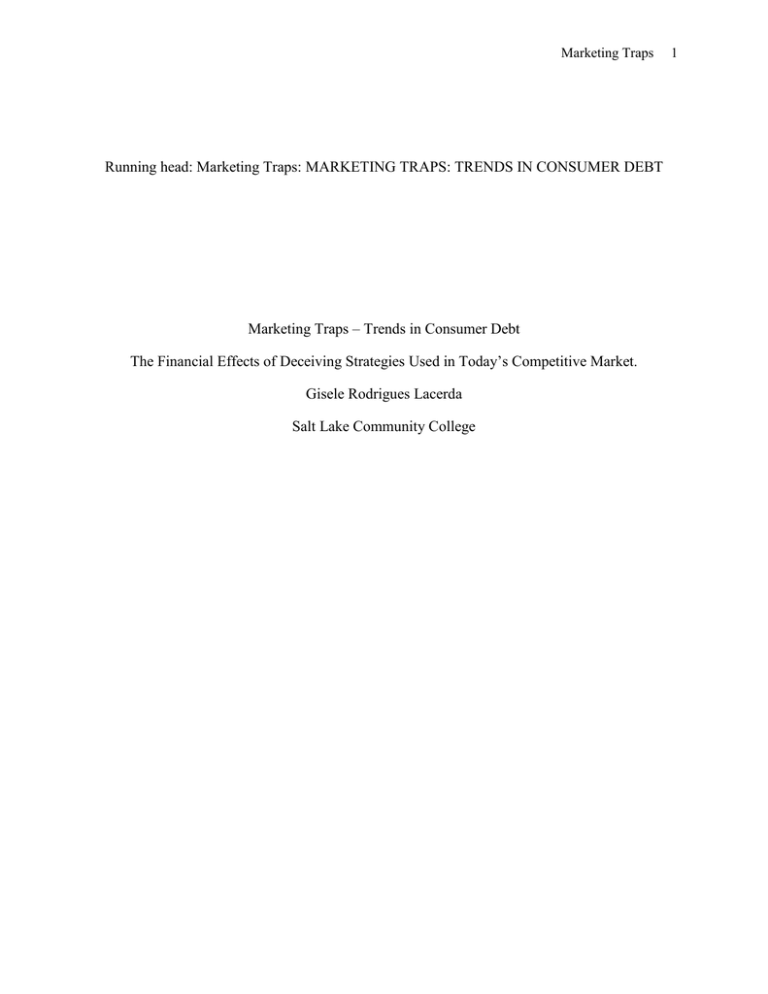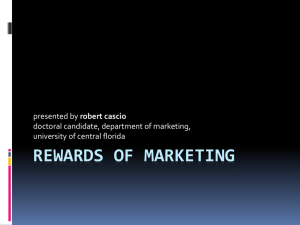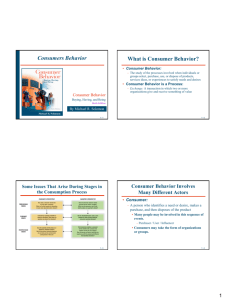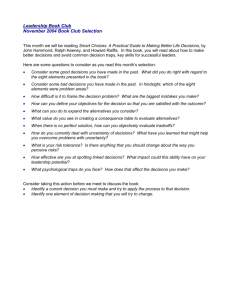File
advertisement

Marketing Traps Running head: Marketing Traps: MARKETING TRAPS: TRENDS IN CONSUMER DEBT Marketing Traps – Trends in Consumer Debt The Financial Effects of Deceiving Strategies Used in Today’s Competitive Market. Gisele Rodrigues Lacerda Salt Lake Community College 1 Marketing Traps 2 Today’s competitive world market is more innovative than ever and information technologies are paving a new road for consumer relations. With the economy still struggling, businesses are taking a more aggressive approach to consumer persuasion by targeting specific groups that are easily persuaded by the concept of saving money—now. Contract abiding, tie down strategies are now used to compensate for lost customers and promotional advertising suddenly exempts loyal customers who solely contributed to the expansion of the company in the first place. Previous methods of selling, researching, product planning, distribution and promotion are faced with challenges never presented before as a result of new information technologies. Consumers have also been faced with challenges that demand new, creative, financial strategies. As a result, the market is making significant contributions towards advertising. Persuasive, direct emphasis on the purchase decision process and product analysis geared towards the individual consumer, both prove the undeniable power consumers have on today’s competitive market. Consumers not only impact the market by consumption and sales profits but they are now able to provide constant feedback in regards to products purchased online, giving marketers the upper hand in promoting access to niche markets. The internet has also made it possible to have goods delivered right to our door, from many different corners of the world. Convenience, real time, customized product/service options make shopping online an appealing, consumercontrolled experience. There are many factors that come into play in advertising. Consumers should take all these factors into consideration when a particular product strikes motivation. Social class, gender, age, religion, price, ethnicity, reference group, product, promotion, place, and the list goes on and on. Effective marketing targets its main reference group by appealing to the Marketing Traps 3 consumer in a psychological state called involvement. Marketers target consumers based on individual needs and values. For these specific reasons alone, we as consumers should be a bit leery when purchasing products we would not purchase otherwise. Marketers are well aware that advertising and targeting specific groups is ultimately increasing market profits nationwide. One may think this is actually helping the economy when in fact it is only increasing overall consumer debt. Our nation has become depended on insufficient funds as a means of living and consequently, it is dreadfully frightening to imagine what the future holds for generations to come. Recent statistics from the federal reserve research department indicate first time home buyers who received the federal income tax rebate, increased their overall monthly expenses by over $200 a month for nine months following the purchase of their home. Those who used the rebate to pay down debt immediately increased their spending habits shortly thereafter. It has been proven time and time again that we are more likely to spend money knowing we have some means of paying it back or simply by knowing the extra cushion is there if needed. Surprisingly enough, our economy continues to take a dive as if no lessons were learned from the hardships behind us. Credit cards also raise concern as a significant contribution to the overall national debt, particularly among college students. Naturally increased debt will ultimately decrease consumption which can eventually eliminate jobs and leave more and more people dependent on unemployment, social security, and other means of unearned income such as welfare services. In directly targeting specific groups, marketers seemed to have overlooked an important money making factor; building customer loyalty. Deceitful tactics previously seen in credit card Marketing Traps 4 marketing are now transitioning into the communications world. Cell phone and internet companies are now using new customer promotions to lure consumers into contract abiding penalties which ultimately create more debt. This not only eliminates returned customers but it also demolishes the firm’s reputation, particularly by word of mouth. In the meantime, marketing researchers and specialist are taking full advantage of the opportunities granted as a result of our crashing economy. Not fully acknowledging they are only hurting themselves by creating further financial hardships for future customers down the road. Recent research from the Journal of Advertising indicates investments in advertising have not only increased sales during the recession but it has also significantly increased sales for up to three years following. As consumers in a time of need, it is only apparent that we take the initiative to resist the temptations provided in today’s strategic targeted market. Our contributions may very well make someone rich while creating financial burdens for ourselves and our families. It is important to put our own needs and the needs of our families first and foremost. By adapting new lifestyle choices and effectively managing our finances we may be able to reshape the American dream from having everything to having enough and being secure. Financial stability is possible when we are able to separate the things we want from the things we need. Let us reform a new age in marketing where customer demands are truly met to our satisfaction without compromising our financial stability or integrity for that matter. Recognizing targeted groups is key in identifying the target. Becoming familiar with these strategies may not only provide financial stability but it may also provide new opportunities for ourselves as consumers not to mention consumers for generations to come. Marketing Traps 5 Works Cited Graham, C. Roger & Frankenberger, D. Kristina. (2011). The earnings effects of marketing communication expenditures during recessions. Journal of Advertising, 40(2), 5-24. Kay, M. (2010). Marketing and the Effects of Recession. Phi Kappa Phi Forum, Summer 2010, p 18-19. Retrieved from: http://web.ebscohost.com/ehost/pdfviewer/pdfviewer?sid=26e7375459b5- 4d4a-bf4f-8bc95553ff89%40sessionmgr104&vid=9&hid=126. Journal of Marketing Research. (2011). RSF-funded Issue on Consumer Finance. Retrieved November 20, 2011, from: http://www.russellsage.org/press-release-journal-marketing-researchreleases-rsf- funded-issue-consumer-finance. Macchiette, B., & Roy, A. (2001). Taking Sides: Clashing Views on Controversial Issues in Marketing. Guilford, CT: McGraw-Hill/Dushkin, A Division of The McGraw-Hill Companies, Inc. Noel, H. (2009). Consumer Behavior. Switzerland: AVA Publishing SA. Sumit, Agarwal (2007). The reaction of consumer spending and debt to tax rebates [electronic resource] : evidence from consumer credit data / Sumit Agarwal, Chunlin Liu, Nicholas S. Souleles. Available from http://lccn.loc.gov/2007615368.






